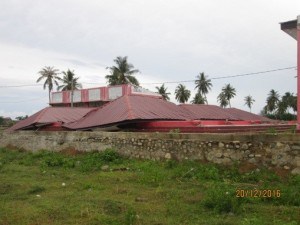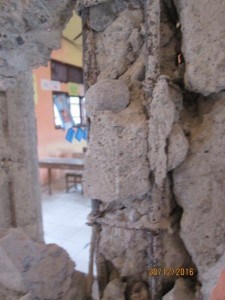Reports after the Pidie Jaya Earthquake – Day 2 : Damages in Pidie Jaya and Trianggadeng
Build Change
Author
In the morning we went to the Pidie Jaya District to meet with the head of the district’s Department of Education (DP). On our way there, we observed some damaged buildings, most of which had suffered wall, column beam, and roof collapses.
We met with representatives from the Ministry of Education, UNICEF, and Save the Children. They are collaborating to build 13 emergency school buildings. They are currently completing structural assessments and intend to complete the construction by December 25, 2016, as requested by the President. The designs have been prepared by the Ministry of Public Works.
We then assessed four schools in the Trianggadeng sub-district, which is one of the areas that was most affected. Three of them are comprised of confined masonry buildings, and one of them has a timber frame and wood panel building. One of the confined masonry schools that we observed is badly damaged, while the rest sustained moderate damage. Common damages that we observed are collapsed gable walls, wall cracking near windows and doors, and separation between columns, beams, and walls. We also observed poor quality concrete made of brittle, round gravel. Exposed rebar on the concrete frames is old and rusted. The bricks are also of poor quality. Most of the roof framings are made from timber, but two buildings have steel frame roofs.
At the end of the day, we visited Kuta Pangwa, the most affected village in Trianggadeng district. It is near MTSN Pangwa, where we visited on Day 1. About 90% of the houses in the village sustained wall and roof damage. All of the confined masonry buildings, which make up a majority of houses, were damaged. Timber frame buildings make up about 15% of houses, half of which were also damaged. 17 people were killed in the village as a result of wall collapses. According to residents, only around 9 houses sustained minor damage, while 110 houses sustained moderate to severe damage. Many affected homeowners are living in tents outside their houses because they are afraid to go back inside.
Building materials are relatively easy to come by. Sand is sourced from a local river, and there are brickmakers that work near the village. We intend to visit the brick kilns on Day 3. Timber, while readily available, is more expensive than brick. With regard to reconstruction planning, all homeowners are currently waiting for the disbursement of government subsidies. Some homeowners prefer to build their homes by themselves or with hired builders. Others prefer to be given the finished product instead of money because they fear that they will spend the subsidy on daily consumption. The majority of village residents are farmers, and a few of them have side jobs as insurance agents or shop owners.
Support resilient housing worldwide
Join us in preventing housing loss caused by disasters.
Donate nowNewsletter
Sign up for our newsletter to receive updates on our latest news, events, and more.



